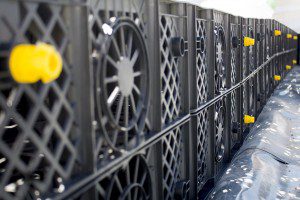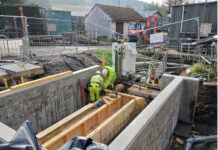
By Hayley Lowry, Marketing Manager at Brett Martin Ltd
AFTER another winter of frequent and high intensity rainfall, tackling surface water flooding remains an issue throughout Scotland. Flood defences are pushed to their extremes and as result there is a renewed urgency on implementing best practice Sustainable Drainage Systems (SuDS) to address surface water run-off, and reduce demands on built drainage and the overloaded sewerage system.
The more we build on flood plains to meet our housing needs, the more we increase flooding problems or exacerbate flooding elsewhere. By adopting a SuDS approach to managing water, housebuilders and developers can manage the risk of surface flooding, integrating these solutions into developments, whilst at the same time influencing other aspects of the site and reducing impermeable areas wherever possible.
Sustainable drainage systems are designed to mimic natural drainage processes as closely as possible by allowing rainfall to soak into the ground where possible or by delaying discharges. Reducing both the volume and rate of surface water run-off to sewers and watercourses, this helps to improve water quality, ecology and amenity value of watercourses. It is important, however, to remember that there is no single drainage solution for any one site and some may not be appropriate or practical in all locations.
There are a number of options from natural above ground SuDS solutions including swales, detention ponds, basins and permeable surfaces to engineered solutions such as concrete culverts, plastic pipes, attenuation tanks and soakaways.
Modularisation is growing in popularity as contractors look to find the next generation of efficient and economical products and systems. Due to the numerous benefits both on and off site, underground modular geocellular units such as StormCrate from Brett Martin Plumbing and Drainage have become an increasingly popular choice at every stage of the supply chain, from the architect and specifier to the contractor and client.
INTELLIGENT STORMWATER SOLUTION
Weighing in at only 18kg per module and measuring 1200mm x 600mm x 420mm, the StormCrate modular units can be easily lifted by hand and then laid or stacked in rows. The units are suitable for a range of applications including residential, commercial and industrial projects.
StormCrates can either be wrapped in a geotextile which allows stored water to slowly seep into the surrounding ground and back into the water table or a more common practice, wrapped in an impermeable geomembrane to create a sealed underground tank. The outlet from this tank is then controlled to facilitate a slow release of the stored water back into the drainage system over a longer period.
Manufactured from recycled plastic, StormCrates have a high void ratio of 95% which means that the units are highly efficient at storing up to 300 litres of water in the event of heavy rains. If inspectability is required for future maintenance, then Brett Martin can offer StormCrate Inspect Crates.
There are no limits on the use and design of the surface over the system and StormCrates may be successfully installed under parking areas, driveways and landscaped areas.
Ideal for domestic soakaways, only 250mm of cover is required above the crates for driveway applications which results in less dig and site spoil. When a minimum of 500mm cover is used, the high strength crate has a lorry bearing capacity of 60 tonnes.
The frequency of extreme rainfall is here to stay which is why engineered solutions such as StormCrate from Brett Martin Plumbing and Drainage can work in association with traditional SuDS solutions to provide effective flood protection for both the short and long term.











